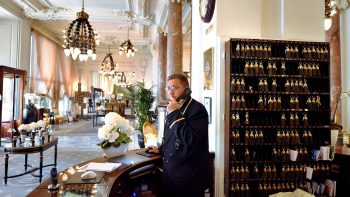Aaron Bachler, an amateur photographer, recently received an email from his mother, who was staying at a hotel at the Grand Canyon. She thought the art hanging on the walls looked like her son’s work. “She said, ‘Boy, these look a lot like yours,'” Bachler says. “And I thought: Where do these hotels buy, y’know, that kind of artwork?”
The answer begins with the hotel owner — and the “brand” of the particular hotel.
“We manage many different brands,” says Hung Luk, COO of the Lam Group, a hotel developer in New York City. “Marriott, Starwood, Hilton…”
All these familiar chains are actually franchises — like McDonald’s or Burger King. Hotel owners pay to share the name, the reservation system and, yes, the “look.” For each hotel, the Lam Group’s architects and interior designers create furniture and finishings within that chain’s “brand standards.”
“A lot of our guests stay with us consistently no matter what city they’re in, so we want them to see some consistency to the brand,” says Terry Brooks, director of product quality for Hilton Garden Inn. “For Hilton Garden Inn, I would describe it as light, bright, airy, very professional but approachable.”
Those “airy” brand qualities can be translated into very concrete design guidelines. Brooks says each Hilton Garden Inn must have two pieces in the lobby from a particular set of approved artworks. A visit to several Hilton Garden Inns around Manhattan revealed the same dot-patterned carpeting, and tree-like pattern on the glass front doors.
When it comes to the art in the guestrooms, guidelines can be just as stringent — Hotel Indigo, for instance, requires black and white photographs from within a few blocks of the hotel, according to hotel art provider Jesse Kalisher.
But people throughout the industry say that over the years, franchises have given owners more latitude when it comes to selecting art.
“When I first got started, I remember the franchise community would say ‘Pick A, B or C art options,'” says Luk, the hotel developer. He describes seeing many landscapes and flowers. “If you travel around the country, you don’t want to see the exact same flower,” he laughs.
But the reason the same flower appeared in many hotel rooms twenty years ago wasn’t just the brands — it was also the technology.
“It used to be just poster art, where everything was on paper and what you saw is what you got,” says Puneet Bhasin, COO of the Artline Group, a hospitality art provider in Hicksville, New York. He says the only technology for getting cheap, mass-produced art 22 years ago was to turn to catalogs of posters that had been mass-produced using offset lithography, the kind of printers used for newspapers.
“The designer would say ‘Send me a catalog!'” Bhasin says. “And we would literally mail them hundreds of catalogs and they would choose the image based on that. But now, with the digital age, all the items are digitized, so you can make whatever color you want, whatever size you want, and you can print them on whatever you want.”
In the entryway to the Artline Group’s office, there are shelves of samples of exotic materials onto which they can print drawings, photographs and paintings.
“These are like MDF boards, which is basically a hard type of wood,” says graphic artist Tony Bracco, knocking on the board to demonstrate. “These are aluminum.”
Not only does digital printing allow a variety of materials, it allows printing a near-infinite variety of images. Bhasin says the Artline Group has access to over 200,000. He says if a single image is licensed for use in a hundred hotel rooms, the licensing fees can drop to as low as a couple of bucks a copy.
The digital approach also allows Artline to accommodate more custom requests, such as the one they received from the Radisson Martinique in midtown Manhattan.
“What they wanted to do was a collage with the Chrysler Building, street signs, the Brooklyn Bridge, street map,” says Artline graphic artist Tony Bracco. “And they had a specific color set: They wanted blacks, whites and gold.”
Bracco used Adobe Photoshop to combine and filter stock photographs to produce new artworks — and so his artworks are prominently displayed in an upscale hotel.
“Yes, but it doesn’t have our names on it unfortunately,” he says.
Then again, to include the names of all the photographers, hotel employees and brand managers whose input resulted in this work — well, that probably wouldn’t fit on the canvas.
There’s a lot happening in the world. Through it all, Marketplace is here for you.
You rely on Marketplace to break down the world’s events and tell you how it affects you in a fact-based, approachable way. We rely on your financial support to keep making that possible.
Your donation today powers the independent journalism that you rely on. For just $5/month, you can help sustain Marketplace so we can keep reporting on the things that matter to you.

















